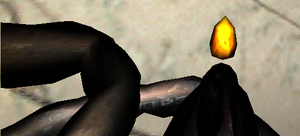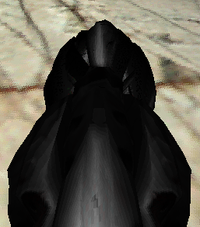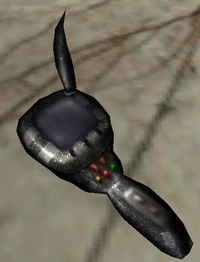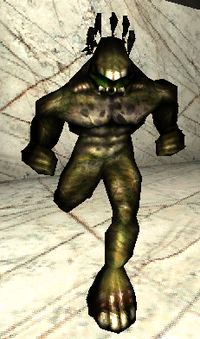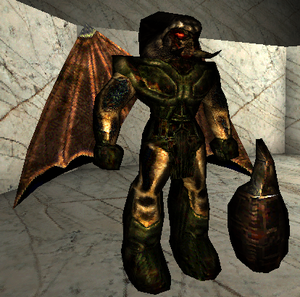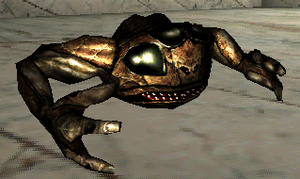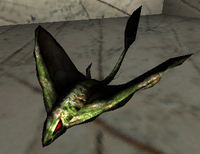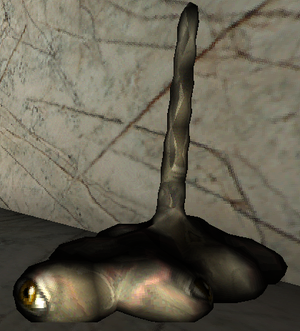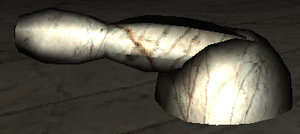Proto:Unreal/Build 0.867z
This is a sub-page of Proto:Unreal.
0.867z is an Unreal prototype compiled on June 18th, 1997. Like the 0.83 prototypes, it comes from an archive of files for Emissary, a canceled game that was going to use the Unreal Engine. It was a code drop Epic Games sent to the Emissary team so that they'd have the latest version of Unreal to work with. It has enemies, weapons, items, and a barebones test map.
This prototype is closer to the final version than previous prototypes were. Several of the weapons from the final version are now in the game, along with some weapons that didn’t make it into the final game. AI for the main enemies, the Skaarj, the Krall, the Titan, and the Brute, are better than they were in 0.864v. However, every other enemy has had little work done on it. It is clear that a lot of work still needed to be done in order to finish Unreal when this prototype was compiled.
General
HUD
0.867z has a new HUD compared to previous prototypes. This HUD is a medium-sized box on the lower-right corner of the screen. Most of the box is taken up by four bars using different colors that have 100 to the right of the bars. The top one is red, which means it probably represents health. The other ones are impossible to figure out. Underneath the mysterious bars are ammo bars that show how much ammo the player has for each weapon.
There's one little problem with this HUD; the bars never move. In fact, the HUD seems to be a mockup. Various pre-release screenshots taken in the middle of 1997 show exactly the same HUD, so it looks like the developers never got around to properly implementing it before it was cut.
| 0.867z Prototype HUD | HUD Seen in Mid to Late 1997 Pre-release Screenshots |
|---|---|
 |
 |
Player Model
The player now uses the final’s Gina model as the default player model. The old Woman model seen in earlier prototypes has been completely removed from the game.
Splash Screen
This prototype features an all-new splash screen. It shows a Skaarj using the Scout texture with a brown overlay and the Unreal logo over it. To the right of the Skaarj is are the developers and publishers. Underneath the Skaarj is “Unreal Virtual Machine. Copyright 1997 Epic Megagames”.
This splash screen managed to survive until the final game, where it was replaced with the word “UNREAL”.
Executables
0.867z still uses UnServer.exe, located in the System folder, to launch the game. Unreal.exe, located in the root folder, just launches UnServer.exe.
Cheats
This prototype has some cheats, but not nearly as many as in previous prototypes.
A table showing off the cheats is below. All of them are typed in the console.
| Cheat | Effect |
|---|---|
| Server god | Enables invincibility. Type again to disable. |
| Server fly | Allows you to fly around. |
| Server ghost | Enables noclip mode. |
| Server Walk | Disables fly or ghost. |
Options
The Options menu seen in 0.83 is still in this prototype, but the audio section has more options compared to its 0.83 version. However, the Video, Devices, Actions and Sensitivity tabs are bugged and will display nothing.
UnrealED
The only difference between 0.867z and the 0.83 prototype's editor is that 0.867z has the Script menu, like the final editor does.
Rendering
Lighting
The lighting is very odd when compared to the final game. It makes parts of models that should be perfectly viewable, such as modeled eye sockets, dark. It also affects how certain models look by giving them colors that don't appear on their texture sheet. This is most noticeable while holding the Eightball. When held, the gun has colors not seen in the final version. However, when its texture is viewed, it looks just like the texture used for the Eightball in the final game.
Fat Objects
Some objects, such as ammo pickups, will become really fat-looking when the player is close to them.
Color Modes
8-bit, 16-bit and 32-bit colors are supported in this prototype. However, since 32-bit works just fine (unlike in 0.83), there's no reason not to use the others.
Weapons
At this point, several of the weapons that appeared in the final game are in this prototype. All of the weapons that aren't placed in the center of the screen by default, such as the Automag, are placed on the left side of the screen. In the final game, they can be placed on the left, right or center of the screen.
All of the weapons that appeared in this prototype have different firing sounds compared to the final game.
Automag
The Automag uses the same model seen in the 0.83 prototypes, but with a few additional animations and a different skin. This skin is a dark brown color and makes the Automag look worn.
The gun has been repositioned so that it appears on the left side of the screen, not the center (like in the 0.83 prototypes). When the gun is taken out, the character will tug on the slide.
Unlike 0.83, spent casings are ejected from the gun when it is fired. This appeared in the final version.
Like in 0.83, the Automag does not need to be reloaded.
Fire modes are the same as they are in the final game. However, when the player hits the alt-fire key, the hand holding the gun will move into position before firing instead of immediately firing sideways. This did not happen in earlier prototypes.
The firing sound is similar to the one the Automag uses in the 20x revisions of Unreal.
| 0.867z Prototype | Final Version |
|---|---|
 |
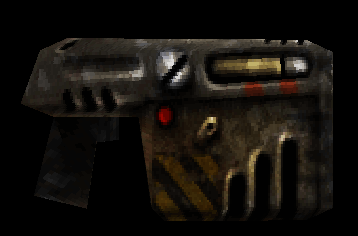 |
| 0.867z Prototype | Final Version |
|---|---|
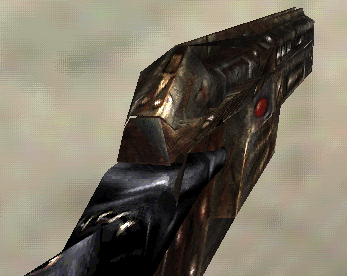 |
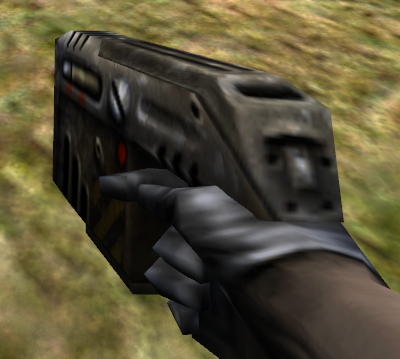 |
| 0.867z Prototype | Final Version |
|---|---|
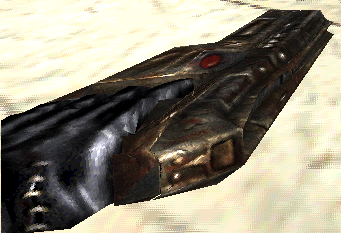 |
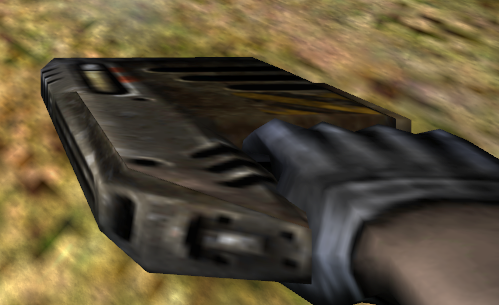 |
| 0.867z Prototype | Pre-release Screenshot Made in the Later Half of 1997 |
|---|---|
 |
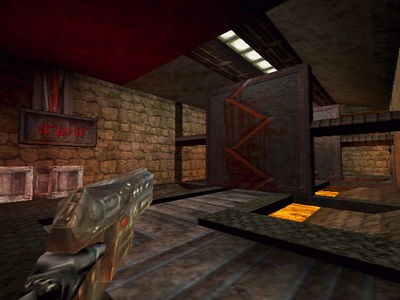 |
| 0.867z Prototype Firing Sound | Final Version Firing Sound |
|---|---|
Stinger
The Stinger behaves exactly like the final one. However, the model is placed further away from the player compared to the final game. In addition, each crystal does 27 damage, which is 13 more than Stinger crystals in the final game do.
| 0.867z Prototype | Final Version |
|---|---|
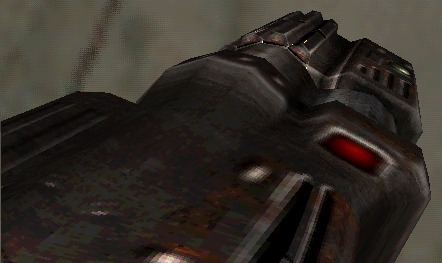 |
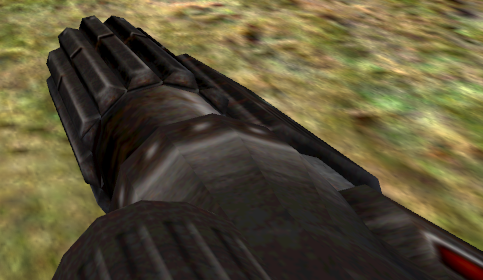 |
| 0.867z Prototype Firing Sound | Final Version Firing Sound |
|---|---|
Flak Cannon
This is the first available prototype that has the Flak Cannon. The model is the same as the final's, but some bits of the part that loads a new shell after firing can be seen sticking out of the back of the gun. The explosion that happens when an alt-fire projectile explodes uses a model in 0.867z, but a sprite in the final game.
Firing modes are the same, but the chunks fired by the gun are much larger than they are in the final game.
| 0.867z Prototype | Final Version |
|---|---|
 |
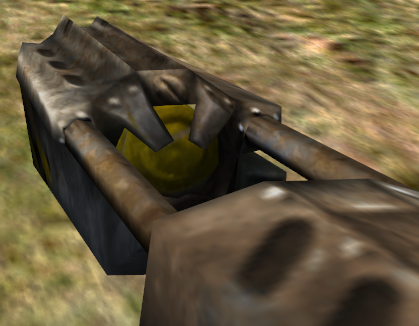 |
| 0.867z Prototype Alt-Fire Explosion | Final Version Alt-Fire Explosion |
|---|---|
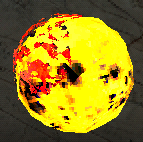 |
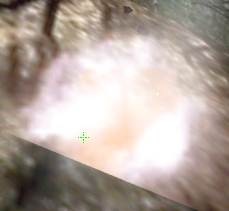 |
| 0.867z Prototype Flak Chunks | Final Version Flak Chunk |
|---|---|
 |
 |
| 0.867z Prototype Firing Sound | Final Version Firing Sound |
|---|---|
Eightball
Visually, the Eightball is nearly the same as it is in the final game. The only difference is that, when held, the gun is placed further up in this prototype compared to the final game.
The firing modes are almost the same as well. The firing modes behave the same as they do in the final game, but there is one small difference; when firing a volley of rockets, the rockets will always use the circular pattern that is used as an alternate rocket pattern in the final game. The spread that's used by default in the final game does not appear. The lock-on seen in the final game works like it does in the final game.
If a rocket is fired right next to a wall, the rocket will bounce off the wall instead of exploding.
Occasionally, if a volley of grenades (the alt-fire) are shot, one of them will hit the other, causing both of them to explode.
When a rocket explodes, the explosion is represented by a model. The final version uses a sprite to represent a rocket exploding.
Both the rockets and grenades fired by the Eightball in 0.867z do 125 damage. In the final game, rockets do 80 damage, while grenades do 100 damage.
| 0.867z Prototype | Final Version |
|---|---|
 |
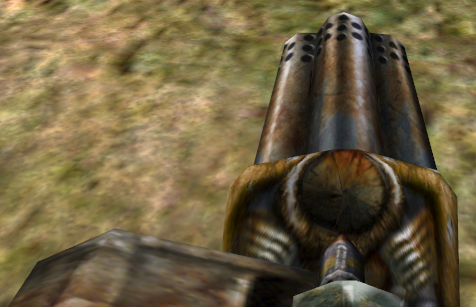 |
| 0.867z Prototype Rocket Explosion | Final Version Rocket Explosion |
|---|---|
 |
 |
| 0.867z Prototype Firing Sound | Final Version Firing Sound |
|---|---|
Razorjack
The Razorjack is almost the same as the one that appears in the final game. The only differences are that the blades lack the purple trail behind them when they are first fired and the held model is a bit further up on the screen compared to where it is positioned in the final game.
A look at the code for the Razorjack's projectiles shows that it does the same amount of damage that it does in the final game, but lacks the coding for headshots.
| 0.867z Prototype | Final Version |
|---|---|
 |
 |
| 0.867z Prototype Projectile | Final Version Projectile |
|---|---|
 |
| 0.867z Prototype Firing Sound | Final Version Firing Sound |
|---|---|
Rifle
The Rifle has some visual issues in 0.867z, but works just fine. The main problem is that, when holding the Rifle, it is placed so that only the end of the barrel can be seen. It seems this happens because the gun has no model for when it is being held. Instead, the game has been instructed to use the third person model, but it isn't placed on the screen properly.
Primary fire is the same as the final, but the secondary fire activates a flashlight. In the final game, there is a separate flashlight object and the Rifle's secondary fire activates a zoom.
| 0.867z Prototype | Final Version |
|---|---|
 |
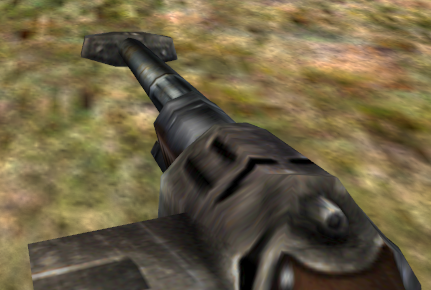 |
Flamethrower
This weapon is never seen in the final version. It is a device with a long tube on its left and a modeled flame in front of it. However, if either the fire or alt-fire keys are hit, nothing happens. A quick look at the weapon's code reveals that the only code that exists for it simply makes it exist as an item that can be picked up and nothing more. It seems the developers never got a chance to make it work as a weapon before they removed it.
An interesting thing to note is that the Flamethrower has no proper model for it as an object. When placed in a map, it is represented by a tiny version of the model used when holding it.
Impaler
The Impaler is another weapon that didn't made it to the final version. It is a staff with an iron, star-shaped end that has one of the "arms" of the star longer than the others. In the center of the star is a purple crystal. When held, the crystal spins around and some polygons move around it to indicate electricity sparking. The model used for it when it is an item has a minor visual bug; some loose polygons can be seen behind the wooden end of the staff.
The Impaler has two firing modes. The primary fire shoots a red laser. The secondary fire mode shoots a purple crystal that's shaped exactly like the one on the staff. When the purple crystal hits something, it explodes. Both attacks do the same amount of damage; 10. If projectiles from either firing mode hit a wall the player is next to, the player will be hurt.
Each firing mode does a pitiful amount of damage. However this can be attributed to a testing phase of the gun and it's clear the damage/modes would be refined later on as the projectiles take the default damage. In the way it's implemented, the gun seems to be most useful against Titan as it is effective in blasting his boulders.
Interestingly, this weapon is mentioned in the Unreal Bible design document. The primary fire more-or-less matches how it behaves in 0.867z, but the secondary fire is completely different. Instead of firing a purple crystal, the gun would fire a continuous energy beam that would home in on enemies. It would be split if there were multiple enemies nearby. A leftover file from mesh texturing tool reveals that Impaler had originally a completely different mesh with two-slot skin and a slicing melee animation. This mesh however remains lost.
Stunner
The Stunner also does not appear in the final game. At first glance, it appears to be a purple and pink shell. When picked up, the purple and pink parts will briefly fold back, exposing a rod in the center of the gun. Then, the parts will fold back. When holding the weapon, the rod can be seen poking out of the shell. In the item model, the rod is never seen, suggesting the rod poking out is a bug, not something intentional. A control panel will emerge after a gun is selected, however due to the position of the gun, one never gets to see it in-game unless properties are modified.
The Stunner has only one attack. Holding down the primary fire key will make the purple and pink parts of the shell fold back and make small polygons begin to move around the rod in the center of the gun. After holding it for a few seconds, the purple parts will be completely folded back, the polygons around the rod will disappear, and the gun will start to vibrate. Releasing the fire button makes the rod stretch forward for a second, but nothing happens. If the fire key is released before the charging animation is complete, nothing will still happen. A look at the code shows that there is no projectile for it to use, making it useless.
What's interesting about this weapon is that its behavior is very similar to a weapon in the final game; the Dispersion Pistol. Both weapons have a charging mechanic and will begin to vibrate when the charge is at max power. The Dispersion Pistol also appears in prototypes made after the Stunner disappears. Based on this evidence, it seems safe to say that the Stunner became the Dispersion Pistol. However it might be it evolved into both Tazer (ASMD) and DispersionPistol at the same time, splitting the gun's elements into both.
Like the Impaler, the Stunner is also mentioned in the Unreal Bible. The design doc states that the charging mechanic would be used to create a directed blast of energy that would send enemies away from the player. The weapon would have to be charged in order to do this. The alt-fire mode would send enemies towards the player.
Teleport Gun
This weapon has no model on the ground or when it is held. It shares the same gun slot the Automag has. When the fire key is pressed, it shoots a blue crystal. This crystal will slowly fly in a straight line until it hits a wall. Hitting the fire key after shooting the crystal will teleport the player to wherever the crystal was when hit fire key was pressed. However, after the player has teleported, hitting the fire key will launch a new crystal instead of teleporting the player again. The player can then teleport again.
It seems that this weapon was an early prototype of the Translocator seen in later prototypes and Unreal Tournament. Both weapons shoot a harmless projectile that serves as the destination point for a teleport. They can also be used once before the projectile has to be shot/tossed again. In addition, the scrapped Translocator for Unreal appears right after the Teleport Gun disappears.
Quadshot
The Quadshot can be placed in levels and picked up, but it is unable to fire. It suffers from the “fat objects” rendering bug when it is picked up. Based on how incomplete it is, the developers had probably scrapped it when this prototype was compiled.
Items
Detector
An unusual item called a Detector can be placed in maps. However, when the game is actually run, the Detector is invisible and does nothing when picked up. The item has the bare minimum amount of coding needed for it to exist. Unreal Bible has this item listed as Motion Detector and resembles slightly the one in the original Alien movie and would work similarly to translator except would show the detector screen.
Lava Boots
The Lava Boots are another item that can be placed in a map, but won't actually appear when the game is started. However, when seen in the editor, they are a large version of the final's jump boots! Looks like the developers had a completely different purpose for the boots when they were first implanted. Based on their name in this prototype, the original idea was to use the boots as a way to safely walk over lava. Instead, they changed them into the jump boots known and loved by Unreal fans. The item was called Asbestos Boots in the Unreal Bible, but Anti-Gravity Boots were there as well which were supposed to be drawn more techy. It's possible that when Lava Boots were dropped, the skin was decided to not change.
Flashlight
The Flashlight from the final game can be found in the editor and placed in a level, but it does not appear when the level is loaded. When looked at in the editor, it suffers from the “fat models” bug.
Armor
Armor looks the same as it does in 0.83, but cannot be picked up. Looking at the log the game makes, the game registers the player picking up the armor, but nothing happens.
Health
Health looks the same as it does in the final game, but now gives 20 health, like in the final game, instead of 30. It also suffers from the “fat model” bug when the player gets close to it.
Clip
The Clip looks the same as it does in the final game, but isn't picked up when walked over.
Crystals
Crystals look like they do in the final game, but nothing happens if they are walked over.
Shells
Shells for the Quadshot are in the game, but like the other ammo pickups, do nothing when walked over.
Enemies
Almost all of the enemies from the 0.864v prototype can be found in 0.867z, but most of them have barebones AI most likely used as temporary coding until they could get proper AI done for them. However, some enemies have AI and behavior that is quite close to how they behave in the final game.
The only enemy that appears in 0.864v, but not 0.867z, is the Dragon.
Skaarj
The Skaarj uses the final's model, sounds, and the final's Skaarj Warrior texture. His AI is much more complete compared to the Skaarj seen in 0.864, but he still lacks the ability to dodge projectiles. The projectiles shot by the Skaarj look like the projectiles fired by the Impaler's alt-fire, not the blue crystals seen in earlier prototypes.
Some of his sounds are similar to the ones used in the final game, but actually don't appear in it. They seem to be earlier takes on the style that would be used for the Skaarj.
| 0.867z Prototype Skaarj Sound | Final Skaarj |
|---|---|
Krall
The Krall looks much different than he does in both the earlier prototype and the final game. He has a dark blue skin with red eyes and a red horn thing on his head. This skin appeared in several pre-release screenshots taken in during the middle of 1997.
His AI is much more complete compared to 0.864v. He is able to walk without constantly stopping. However, he will not attack unless shot at first. If he sees the player, he will stare at them and occasionally move a few meters.
The Krall has two attacks; firing a laser and a melee attack. At range, the Krall will fire red lasers from his staff. The laser does 15 damage and uses a model that looks identical to the projectile fired by the Impaler's primary fire. The melee attack does 20 damage.
He has three sounds, which is far fewer than what he has in the final game. In addition, the sounds available sound a bit different than he does in the final game.
| 0.867z Prototype | Final Version |
|---|---|
 |
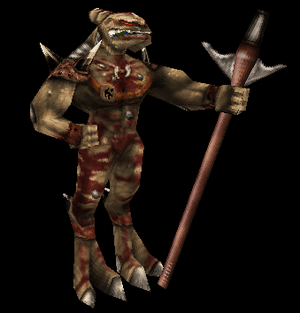 |
| 0.867z Prototype | Final Version |
|---|---|
 |
 |
| 0.867z Prototype Krall Sound | Final Krall Sound |
|---|---|
Brute
The Brute uses the same skin he had in 0.83 and 0.864v, but his behavior is closer to the final's than in previous prototypes. He now fires rockets, like he does in the final game. However, he fires them at a slower rate and the rockets use the Eightball's rocket model, instead of their own unique model. He also never rages when his health is low, like the Lesser Brute and Brute do in the final.
The Brute sounds a bit different in 0.867z than he does in the final game. He sounds a lot for a lack of better term, fatter than he does in the final game.
| 0.867z Prototype Brute Sound | Final Brute Sound |
|---|---|
Titan
Unlike 0.864, this prototype has a fully functioning Titan. There are some small differences between the 0.867z and final Titan, but he's mostly the same as he is in the final game. He lacks some of the final's animations, like the one where he is sitting in a throne and gets up from it.
First, the small rocks the Titan throws do much less damage. A single rock does 30 damage in this prototype, but does a whopping 300 in the final game. This change makes the Titan much more of a threat. Second, the Titan will never throw a large rock at the player. Instead, he always throws two small rocks.
He has only one death animation in 0.867z; the one where he grips his chest and slowly goes down. The other two death animations cannot be found in this prototype.
The Titan's sounds are more subdued compared to the final game.
| 0.867z Prototype Titan Sound | Final Titan Sound |
|---|---|
Slith
The Slith has no animations nor attacks, but has a very basic AI. If the player is on the same floor that the Slith is, he will run up next to the player and do nothing. If the Slith cannot reach the player, he will slide from side to side until the player returns.
He uses the same skin that the 0.864v Slith uses.
Pupae
At first, the Pupae appears to have no AI, like he does in 0.864v. However, if he is shot, he will begin bouncing around from side to side while sliding, like the Slith. Unlike the Slith, he will never run up to the player.
The Pupae uses the same skin seen in 0.864v.
Warlord
The Warlord has the same skin seen in 0.864v. When shot, he will begin bouncing around, like the Pupae does. If he is killed, the game will crash.
Queen
The Queen still has no texture, like in 0.864v, but has very basic AI. As soon as she sees the player, she will run next to them, but do nothing when she reaches them. If she is unable to pursue the player, she will slowly bounce around.
Mercenary
The Mercenary looks the same as he does in 0.867v, but has basic AI that will activate when he is shot. After being shot, the Mercenary will begin sliding around, stopping, and occasionally bouncing off of walls. He does not attack.
Fly
Compared to her final skin, the Fly has a darker skin with more defined parts. The transparency effect around her wings are broken, giving her wings a black outline. However, the Fly has no AI and will appear with her tail facing the floor if she is placed in a map.
Gasbag
The Gasbag looks the same as he does in 0.864v and has no AI.
Manta
The Manta looks like he does in 0.83 and 0.864v, but has no AI.
Blob
The strange Blob enemy seen in 0.864v returns in this prototype, but still has no AI nor animations. When killed, the game crashes.
Hawk
The Hawk enemy found in 0.864v, but not the final game, appears in this prototype. He has no AI and the game crashes when he is killed.
Squid
The Squid monster found in the final's game files and 0.864v appears in this prototype. He has the same barebones AI coding that the Slith does; it will run up to the player and stand there if he can reach the player.
Turret
The Turret from 0.864v still lacks a proper texture, but has a very basic AI that activates when shot. When it has been shot, it will begin to move around and will occasionally try and ram into the player. After a second or two of rubbing against the player, it will move away and try it again.
Nali
The Nali uses the same skin he uses in 0.864v. At first, the Nali will just stand there. If shot, he will begin to pursue the player. When he gets next to the player, he will stop. He'll move again if the player moves.
Cow
The Cow looks the same as he does in 0.864v, but has some strange quirks. First, when the Cow is placed in a map, it will be placed with his tail touching the ground. Second, the Cow will begin pursing the player as soon as the player spawns in. In the final game, Cows are docile and will never charge the player.
Firefly
The Firefly can be placed as an object in 0.867z in two ways; as a single Firefly or as a swarm of them. However, only the single Firefly shows the actual model. The Firefly swarm uses the default pawn icon. The single Firefly has no AI, but the temporary Firefly swarm does. When shot, they will begin to bounce around from side to side. This is most likely because the Firefly swarm is just a generic pawn, and the AI is a part of the default pawn package.
Razorfish (Devilfish)
A pawn for the Razorfish (early name for the final's Devifish) enemy exists, but when placed, he uses the default pawn icon. There is no model for it hidden in the code and he has no AI.
Humans
Pawns for both male and female characters are in the game. The woman is Gina, while the man is an early version of the final's Male1 model. Both of them appear to be unchanged from 0.864v. When placed in a map, they'll quickly slide around the map in random movements. Their sliding around will eventually make the game crash for some reason.
The woman model has most of the animations she uses in the final game, but the man has no animations.
Woman has a full set of sound effects. They are different from both the ones used in earlier prototypes and the final game. They can be downloaded at File:Unreal867playersound.rar. The man has no sounds.
Levels
This prototype has only one level; Unreal.unr.
Unreal.unr
Unreal.unr is a large test map that uses the default texture.
The player starts out in a medium-sized octagon that has an Eightball, Razorjack, Stinger, and Flak Cannon in it. There is an invisible light providing some illumination. Above the player are two large square areas with a flashing light in them that are both the same. There is nothing in the squares. Above each of them are pitch-black square rooms that have nothing in them.
That's it.
Gate Executables
Inside the prototype's files is a folder called “Gate”. In it are two executables, GateCli.exe and GateSrv.exe. These are actually tools for starting and maintaining a dedicated server. GateSrv.exe will not run if started manually. GateCli.exe needs to open it in order for it to work.
When GateCli.exe is started, it will show a small launcher asking if you want to start a dedicated Gatekeeper or remotely administer another one. If you wanted to administer one, you can add its information to a list so that you can admin multiple ones. Selecting the “Start a new one” option, then hitting OK will show a box where you can fill out things like the port that will be used. Hitting OK will send you to a large screen with multiple tabs with a log at the bottom. This appears to be used for administering a server.
The first tab is “Levels”, which allows you to set what levels will play on the server and what order they'll play in. You can also change properties, such as add a password allowing a person to watch that specific level and the maximum amount of players that can be in that level.
The second is “Gatekeeper”, which allows you to set information about who is currently watching the server as an admin. You can also set the map directory and add multiple ones, along with setting up information about uplinking.
Properties gives an overview of everything that can be modified and allows you to change them if you want.
“Users” shows a list of users in the server. It shows their name, type of user they are, what team they're on, what level they're in, the application they're using to access the server, and their access. From there, the admin can broadcast an entire message throughout the server (broadcast), send a specific user a message (message), or kick (banish in the program) a user.
The last tab, “About”, describes what Gatekeeper does.
Download Link
0.867z Prototype: http://www.legendsworld.net/site/download.php?mirror=6908
0.874d Prototype: http://www.legendsworld.net/site/download.php?mirror=6911






